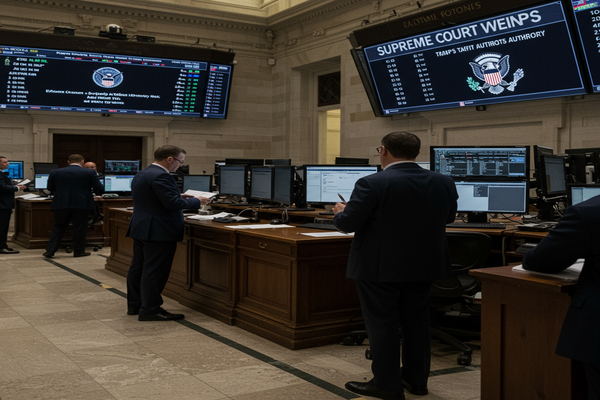
Supreme Court hears challenge to Trump’s tariff authority. Oral arguments at the U.S. high court will decide whether the president can rely on a 1977 emergency law to impose broad import levies. The ruling matters now because it could immediately affect tariffs that range from about 10 percent to around 50 percent on Chinese goods and an effective consumer tariff rate that Yale researchers put at 18 percent, the highest since 1934. In the short term markets face continued cost pressure for manufacturers and retailers. Over the long term the decision will set a precedent for executive trade power with global implications for the United States, Europe, Asia and emerging markets.
Legal test of executive power and immediate market consequences
The Supreme Court hearing centers on use of the International Emergency Economic Powers Act of 1977. Several lower court judges have ruled against the president’s use of the law to raise tariffs. Opponents argue that the Constitution gives Congress, not the president, the authority to impose taxes and tariffs. The case matters now because oral arguments could signal how quickly uncertainty around the duty schedules will clear.
If the court restricts presidential authority, some tariffs could be rolled back or require fresh congressional approval. Meanwhile the White House is pursuing separate import investigations that could preserve levies even if the court rules against the administration. That dual track raises short term complexity for importers and supply chains. Traders will parse the decision for immediate effects on commodity flows and on sectors that have been directly hit by duties.
How companies are coping with higher costs
U.S. manufacturers and retailers are absorbing or passing on increased costs in different ways. Heavy equipment maker Caterpillar (NYSE:CAT) says it plans to absorb a large share of tariffs and estimates costs of about $1.6 billion to $1.75 billion in 2025. Other firms are harder pressed. Capri Holdings (NYSE:CPRI), owner of Michael Kors, reported a surprise loss and cited tariffs as a factor that could hit margins in its current quarter. Automakers have pushed the White House to extend terms under the North American free trade deal they see as vital to production.
Some manufacturers have shifted production from one country to another to try to reduce tariff exposure. Those moves are costly and often slow. In many cases firms find it impossible to fully outrun levies because of supplier networks, regulatory constraints and timing. The result is mixed corporate performance across sectors and continued downward pressure on manufacturing sentiment in the U.S.
Global trade relations and policy measures affecting markets
The dispute over tariff authority plays out alongside negotiations with major trading partners. Within U.S.-China ties the administration has blocked sales of certain advanced AI chips to China and said Nvidia (NASDAQ:NVDA) cannot export its top-tier devices to the world’s largest importer. China has taken reciprocal steps on trade in some areas while lifting tariffs on selected U.S. farm goods. Beijing still keeps higher duties or restrictions on important commodities like soybeans.
Separately the U.S. keeps a high 50 percent duty level on certain Indian imports, while talks with India continue. China has moved to ban some foreign AI chips from state funded data centers and to suspend or roll back retaliatory measures in other areas. These actions create uneven sectoral impacts. Semiconductor stocks and equipment suppliers will watch chip export controls closely. Agricultural markets will track any further changes to Chinese farm tariffs. Financial and industrial investors will watch for policy moves that could shift trade flows between Asia, Europe and the Americas.
Market scenarios and policy uncertainty
Markets face several plausible scenarios and each has distinct implications. A ruling that limits presidential tariff authority would remove a legal basis for some levies. That could ease cost pressure for import reliant sectors and support shares in consumer goods and retail. However, the White House can still keep tariffs in place through investigations, which would temper relief.
If the court upholds the administration’s approach, tariffs could remain a durable input cost for U.S. companies. That outcome would reinforce the need for firms to adjust supply chains and could sustain higher inflationary pressure for traded goods. Global investors would focus on earnings hits for asset heavy manufacturers, retailers and consumer names that have less pricing power.
Policy signals beyond the court will matter as well. Export controls on AI chips and selective tariff rollbacks or reimpositions by Beijing will ripple through semiconductor supply chains. Political developments, including trade talks between the United States, China and India, will shape investor expectations for trade volumes and global growth prospects. The interaction between judicial, executive and diplomatic moves creates a complex policy mix for markets to price.
Key takeaways for market participants
The Supreme Court hearing is the immediate catalyst. Traders should watch the decision timeline and read the justices’ questions for hints about the outcome. Companies that have announced measured absorption of costs, such as Caterpillar (NYSE:CAT), may still face margin pressure if tariffs persist. Firms with limited pricing power, including some retailers and apparel names, remain vulnerable to higher duties that reduce margins.
Globally, export controls on cutting edge chips will tilt risk toward technology hardware and equipment providers. Agricultural and commodity markets will track Chinese tariff adjustments for any sign of restored demand. Policymakers will continue to use trade tools as leverage in wider geopolitical talks. For now, markets must weigh immediate cost impacts and longer term changes to the balance of trade authority between branches of government.












